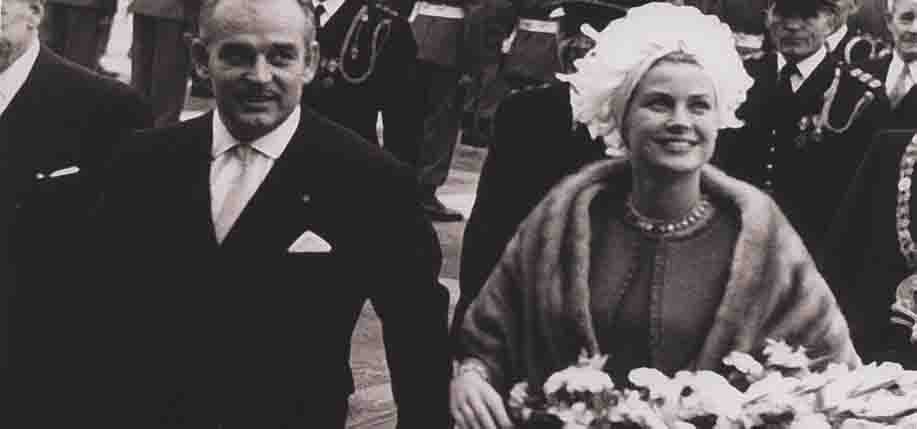The Irish flag flew over Sotheby’s on October 15, 2007 when the exhibit “Grace, Princess of Monaco: A Tribute to the Life and Legacy of Grace Kelly” opened as part of a ten-day “Celebration of Grace” in New York marking the 25th anniversary of her sad passing on September 14, 1982. The tricolor was most appropriate because both the New York exhibit and “The Grace Kelly Years,” an amazingly complete retrospective mounted at the Grimaldi Forum in Monaco this summer, left no doubt as to Grace Patricia Kelly’s pride in her heritage as expressed in both her public and private life. And it’s she herself who speaks, through the souvenirs of a lifetime. Grace Kelly saved everything. Here’s her scrapbook from age eleven with a script from Don’t Feed The Animals performed at a local community center, which she labels “my first part.” Carefully pasted on another page is the Kelly Christmas card in which the face of an even younger Grace is superimposed on a drawing of a colleen. The greeting reads:
Gracie put the kettle on
Gracie put the toast on
Gracie put the sugar on
The Kellys want their tea.
She preserved her baptismal certificate from St. Bridget’s Church, Philadelphia and an invitation to the marriage of her parents, Margaret Katherine Majer and John Brendan Kelly at the same church. In the wedding picture her father wears a morning suit, a top hat and a big smile.
He seems to be enjoying the success he has achieved – he was a man who laid bricks himself before making Kelly Brickworks a hugely successful construction company. The Monte Carlo exhibit presented a 20-foot brick wall replica of the yard, and in New York the “Kelly for Brickworks” tee-shirt got pride of place. The Kelly crest with its rampant lions, tower and the motto “Turris Fortis Mihi Deus” – God is my Tower of Strength – is displayed as well as the Kelly Family Champagne Toast:
So children dear, while we are here
Let’s drink a little toast
The world is at your fingertips
So make the very most.
This juxtaposition reveals something about the character of Irish immigrants like Grace Kelly’s grandfather John Henry Kelly. He came to Philadelphia in 1869 from an Ireland shattered by starvation and oppression and yet managed not only to survive, but to imbue his son with the conviction that the world can be at your fingertips. Perhaps Princess Grace was thinking of him and her grandmother, Mary Costello, when she composed her speech accepting the position of International Chair of the Irish-American Cultural Institute in Dublin in 1973. The hand-written draft reads “I think it was the Institute motto – ‘Not ancestor worship but filial gratitude’ – that attracted me first and I am very proud to join in the effort to spread knowledge of the history of Ireland as well as the many valuable contributions to both the old and new world made by Ireland’s sons and daughters. It is a rich heritage and one we all treasure – and it is my sincere hope to be long associated with you in this common endeavor to offer our children and friends whatever gifts we can cull from the nobility of the lives of a great people.”
She preserved some of this “rich heritage” through the collection of Irish books and manuscripts in the Princess Grace Library and affirmed her personal connection in June 1961 when she visited Ireland, returning to her ancestral Mayo where she would buy a house.
On this trip she wore vivid green – Givenchy designed – and chose the same suit for lunch at the White House with President John F. and Jacqueline Kennedy earlier that year – an elegant way to “wrap the green flag round me.” This suit was selected by her son and daughters to be auctioned at the 25th Anniversary Princess Grace Awards Gala along with the Helen Rose ball-gown from High Society.
The proceeds will benefit the foundation she created which presents fellowships to artists in theater, dance and film to “support continued excellence” in the arts.
The exhibit provides a bounty of film clips, pictures, costumes and correspondence from her five years in Hollywood during which she starred in ten movies and won an Academy Award for her performance in The Country Girl. We still enjoy films such as To Catch a Thief, Rear Window, Dial M for Murder, High Noon (salary $750 according to the contract displayed). “True Love,” the duet she sang with Bing Crosby in High Society, earned a gold record.
We’re taken behind the scenes too. There’s a note from Cary Grant: “Delighted you are here dear Grace. It will cheer up the whole town. Me too.”
And from Mr. and Mrs. Frank Sinatra: “Thank you for your warm wishes and prayers. Prayers were answered.”
The portrayal of the Monaco years also combines glamour and intimacy.
We see The Wedding from every angle and get a close look at her gowns and jewels. But also displayed in the exhibition is a poem from a seven-year-old Princess Stephanie for her mother’s birthday that starts:
I love you Mother
When I was one
I had just begun.
I love you Mother
When I was two
And nearly new.
The photographs with her children clearly show her love for them and the good times they had together. In several photographs Grace is wearing her Claddagh ring. On her first trip to Ireland, President Eamon de Valera offered to send four-year-old Princess Caroline a pony. In a gesture that would be appreciated by any child ever promised a pony, which is probably every child, Princess Grace followed up with a letter enquiring about the pony’s whereabouts. In a letter dated December 1961, President de Valera replied, telling the Princess that the pony would be leaving for Monaco the first week of January. He explained it took some time for the National Stud to secure a suitable one and make arrangements for transportation.
In a February 1962 letter, President de Valera says he’s “very glad to know that ‘Babbling Brook’ is giving satisfaction, and that your daughter is pleased with her.” He adds, “I was delighted to get the Princess’s letter, which I have shown to my wife.”
In a famous photograph, Grace Kelly looks at President John F. Kennedy (see page 85). Here are two people who embodied so much for Irish America.
Sad that neither reached an age when outside burdens lift and the inner person emerges. This exhibit, arranged by the Consulate of Monaco, the Princely Palace, the Princess Grace Foundation-USA, Van Cleef and Arpels is expected to travel to other cities in the U.S. It’s well worth a visit as it reveals how firmly the girl who became Hollywood star, fashion icon and Grace, Princess of Monaco, held on to her Irish-American identity in ways not seen before.
Gracie, we hardly knew you. ♣
Read John B. Kelly: An American Champion also by Mary Pat Kelly.

Mary Pat Kelly’s celebrated historical fiction series, the bestseller Galway Bay, Of Irish Blood and now Irish Above All tells the Irish American story through her own family’s saga. https://marypatkelly.


Leave a Reply